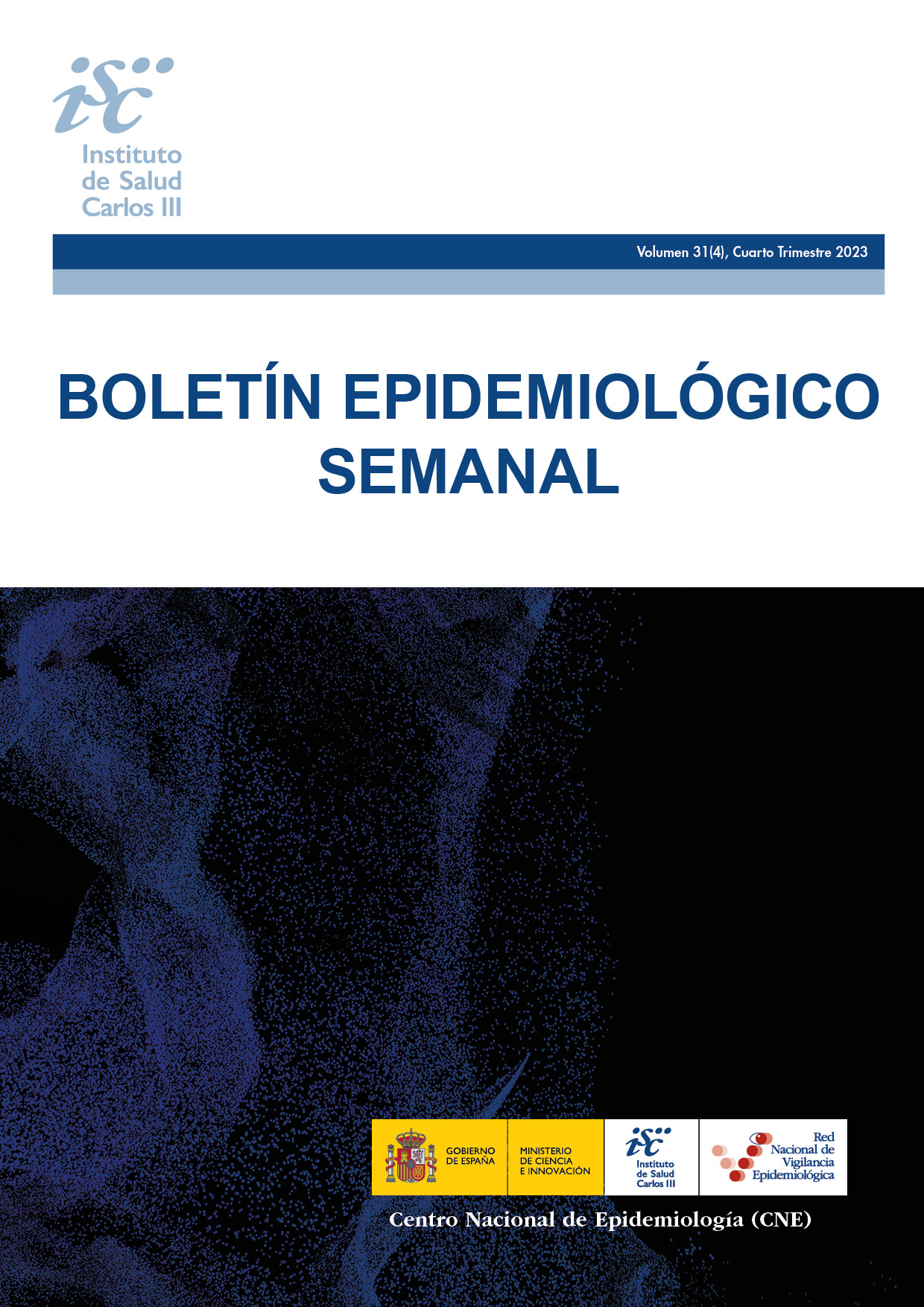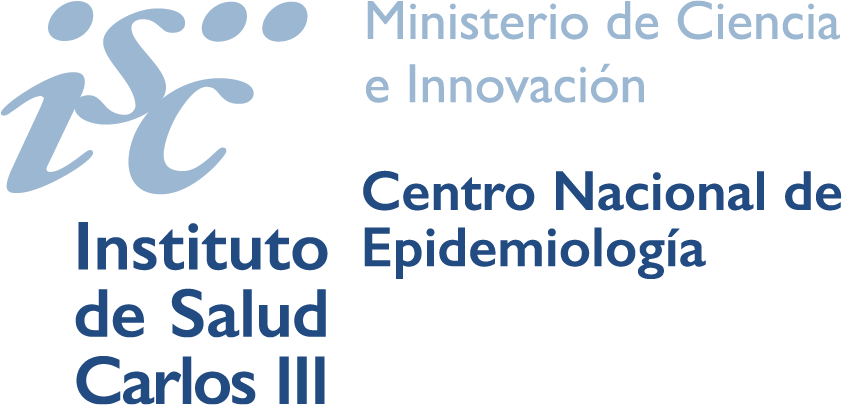Epidemiological situation of hepatitis A in Spain, 2021-2022
DOI:
https://doi.org/10.4321/s2173-92772023000400004Keywords:
hepatitis A, cumulative incidence, epidemiological surveillance, SpainAbstract
Introduction: The hepatitis A virus, which causes an acute liver infection, is transmitted by ingestion of food and water and direct person-to-person contact, especially among close contacts (cohabitants or other specific contexts such as kindergartens or men who have sex with men - MSM). The aim of this study was to describe the temporal trends and epidemiological characteristics of hepatitis A in 2021 and 2022 in Spain, comparing to data from previous years (2015-2020).
Method: We analysed the cases of hepatitis A reported to the National Epidemiological Surveillance Network (RENAVE in Spanish) during the 2015-2022 period, calculating the annual cumulative incidences (CI), globally and by sex and age groups. The main characteristics of the hepatitis A outbreaks notified in 2021 and 2022 were also described.
Results: In 2021 and 2022, the CI was 0.41 and 0.53 respectively, lower than those reported in previous years. No large differences were observed in the distribution between men and women. In 2021, the population group with the highest CI was adults > 44 years, while in 2022 was the population aged up to 15 years. In 2021 and 2022, the CI in population up to 44 years was fewer compared to 2015, while no large differences were observed for the older population.
Conclusions: In 2021 and 2022, the hepatitis A CI was the minimum notified during the study period, with a significant decrease compared to previous years, especially in children and in population aged 15 to 44, possibly due to changes in the epidemiology of the disease by the COVID-19 pandemic and the exceptional situation of the outbreak of the years 2016-2017.
Downloads
References
Costa-Mattioli M, Napoli AD, Ferré V, Billaudel S, Perez-Bercoff R, Cristina J. Genetic variability of hepatitis A virus. J Gen Virol [Internet]. 2003 Dec;84(Pt 12):3191–201. Disponible en: https://doi.org/10.1099/vir.0.19532-0
Averhoff F, Khudfyakov Y, Vellozi C. Hepatitis A virus. In: Bennett JE, Dolin R, Blser MJ, editors. Principles and practice of infectious diseases. 9th ed. Philadelphia : Elsevier, 2020: 2243-2261.
WHO position paper on hepatitis A vaccines – June 2012. Wkly Epidemiol Rec. 2012 Jul 13;87(28/29):261–76.
Ndumbi P, Freidl GS, Williams CJ, Mårdh O, Varela C, Avellón A, et al. Hepatitis A outbreak disproportionately affecting men who have sex with men (MSM) in the European Union and European Economic Area, June 2016 to May 2017. Euro Surveill. 2018 Aug;23(33).
Grupo de trabajo vacunación en población adulta y grupos de riesgo de la Ponencia de Programa y Registro de Vacunaciones. Vacunación en grupos de riesgo de todas las edades y en determinadas situaciones. Comisión de Salud Pública del Consejo Interterritorial del Sistema Nacional de Salud. Ministerio de Sanidad, Consumo y Bienestar Social, julio 2018.
Red Nacional de Vigilancia Epidemiológica (RENAVE). Protocolo de vigilancia de la hepatitis A. Protocolos de la Red Nacional de Vigilancia Epidemiológica. Disponible en: https://www.isciii.es/QueHacemos/Servicios/VigilanciaSaludPublicaRENAVE/EnfermedadesTransmisibles/Documents/PROTOCOLOS/Protocolo%20de%20Vigilancia%20de%20Hepatitis%20A.pdf. Acceso 11 Junio 2022.
Real Decreto 2210/1995, de 28 de diciembre, por el que se crea la red nacional de vigilancia epidemiológica. Boletín Oficial del Estado. Madrid, a 24 de enero de 1996, núm 211 pág. 2153-2158. Disponible en:
https://www.boe.es/eli/es/rd/1995/12/28/2210/con.
Instituto Nacional de Estadística (INE), Ministerio de Asuntos Económicos y Transformación Digital. Disponible en: https://www.ine.es. Acceso 08 Febrero 2022.
European Centre for Disease Prevention and Control. Hepatitis A. In: ECDC. Annual Epidemiological Report for 2021. Stockholm: ECDC; 2022. Disponible en: https://www.ecdc.europa.eu/sites/default/files/documents/HEPA_AER_2021.pdf. Acesso 10 Octubre 2023.
Informe epidemiológico sobre la situación de la Hepatitis A en España. Años 2019 y 2020. Centro Nacional de Epidemiología. Instituto de Salud Carlos III. Disponible en: https://www.isciii.es/QueHacemos/Servicios/VigilanciaSaludPublicaRENAVE/EnfermedadesTransmisibles/Paginas/Resultados_Vigilancia_Hepatitis_A.aspx. Acceso 07/12/2023.
European Centre for Disease Prevention and Control. Hepatitis A. In: ECDC. Annual epidemiological report for 2019. Stockholm: ECDC; 2022. https://www.ecdc.europa.eu/sites/default/files/documents/HEPA_AER_2019_Report.pdf. Acceso 07/12/2023.
Limia Sánchez A, Olmedo Lucerón C. [2nd Seroprevalence Study in Spain, 2017-2018]. Rev Esp Salud Publica. 2021 Mar 18;95:e202103059.
Van Damme P, Pintó RM, Feng Z, Cui F, Gentile A, Shouval D. Hepatitis A virus infection. Nat Rev Dis Primers [Internet]. 2023 Sep 28 [cited 2023 Oct 27];9(1):1–18. Disponible en: https://www.nature.com/articles/s41572-023-00461-2
Murray PR, Rosenthal KS, Pfaller MA. Medical Microbiology. (9th Edition). Elsevier - OHCE; 2020.
Informe epidemiológico sobre la situación de la shigelosis en España. Año 2022. Centro Nacional de Epidemiología. Instituto de Salud Carlos III. Disponible en: https://www.isciii.es/QueHacemos/Servicios/VigilanciaSaludPublicaRENAVE/EnfermedadesTransmisibles/Paginas/Resultados_Vigilancia_Shigelosis.aspx. Acceso 03/11/2023.
Consejo Interterritorial del Sistema Nacional de Salud. Problemas de suministros de vacunas frente a hepatitis A. Recomendaciones acordadas en reunión de Comisión de Salud Pública, 10 de mayo de 2017. Disponible en: https://www.aragon.es/documents/20127/6059157/Problemas_suministro_Hepatitis_A_Recom_SNS_2017.pdf/c27341a6-c44a-0131-0999-696c5a1a3444?t=1563615419594.
Downloads
Published
How to Cite
Issue
Section
License
Copyright (c) 2023 María Guerrero-Vadillo, Marina Peñuelas, Carmen Varela

This work is licensed under a Creative Commons Attribution-NonCommercial-ShareAlike 4.0 International License.
El material creado por un autor puede ser distribuido, copiado y exhibido por terceros si se hace referencia a la autoría. No se puede obtener ningún beneficio comercial y las obras derivadas tienen que estar bajo los mismos términos de licencia que el trabajo original

